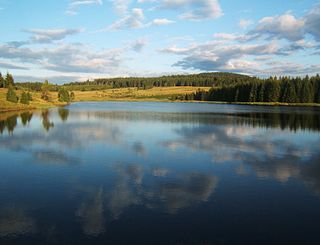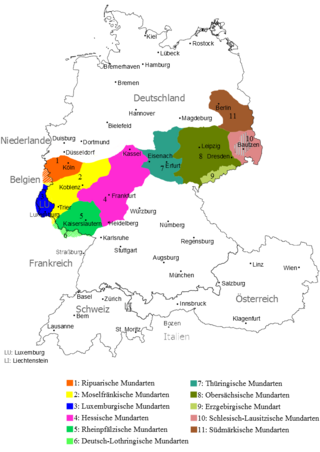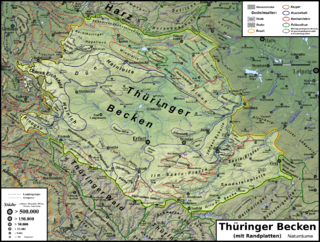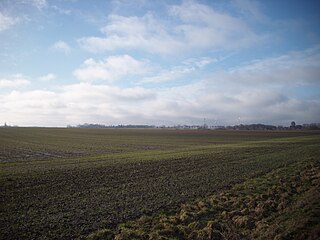
Saxony, officially the Free State of Saxony, is a landlocked state of Germany, bordering the states of Brandenburg, Saxony-Anhalt, Thuringia, Bavaria, as well as the countries of Poland and the Czech Republic. Its capital is Dresden, and its largest city is Leipzig. Saxony is the tenth largest of Germany's sixteen states, with an area of 18,413 square kilometres (7,109 sq mi), and the sixth most populous, with more than 4 million inhabitants.

Thuringia, officially the Free State of Thuringia, is a state of central Germany, covering 16,171 square kilometres (6,244 sq mi), the sixth smallest of the sixteen German states. It has a population of about 2.1 million.

Halle (Saale), or simply Halle is the largest city of the German state of Saxony-Anhalt, the fifth most populous city in the area of former East Germany after (East) Berlin, Leipzig, Dresden and Chemnitz, as well as the 31st largest city of Germany, and with around 239,000 inhabitants, it is slightly more populous than the state capital of Magdeburg. Together with Leipzig, the largest city of Saxony, Halle forms the polycentric Leipzig-Halle conurbation. Between the two cities, in Schkeuditz, lies Leipzig/Halle International Airport. The Leipzig-Halle conurbation is at the heart of the larger Central German Metropolitan Region.

The Saale, also known as the Saxon Saale and Thuringian Saale, is a river in Germany and a left-bank tributary of the Elbe. It is not to be confused with the smaller Franconian Saale, a right-bank tributary of the Main, or the Saale in Lower Saxony, a tributary of the Leine.

The Ore Mountains lie along the Czech–German border, separating the historical regions of Bohemia in the Czech Republic and Saxony in Germany. The highest peaks are the Klínovec in the Czech Republic, which rises to 1,244 metres (4,081 ft) above sea level and the Fichtelberg in Germany.

Leipziger Land is a former district in Saxony, Germany. It was bounded by the districts of Delitzsch, the district-free city Leipzig, Muldentalkreis, Mittweida, the district Altenburger Land in Thuringia, and the districts Burgenlandkreis, Saalekreis in Saxony-Anhalt.

The White Elster is a 257-kilometre (160 mi) long river in central Europe, right tributary of the Saale. Its source is in the westernmost part of the Czech Republic, in the territory of Hazlov. After a few kilometres, it flows into eastern Germany where it cuts through the Vogtland in a "deep and picturesque valley". In Germany it flows through the states of Saxony, Thuringia and Saxony-Anhalt. The White Elster flows through the cities of Plauen, Greiz, Gera, Zeitz, Pegau and Leipzig, and into the river Saale in Halle.

Upper Saxon is an East Central German language spoken in much of the modern German state of Saxony and in adjacent parts of southeastern Saxony-Anhalt and eastern Thuringia. As of the early 21st century, it's mostly extinct and a new regiolect has emerged instead. Though colloquially called "Saxon", it is not to be confused with the Low Saxon dialect group in Northern Germany. Upper Saxon is closely linked to the Thuringian dialect spoken in the adjacent areas to the west.
The Saxon Loess Fields refer to a natural region that lies mainly within the state of Saxony in central Germany. In addition, small areas of this region extend to the northwest and west into Saxony-Anhalt, to the southeast into Thuringia and to the northeast into Brandenburg. It more-or-less combines the BfN's major regions listed as D19 Saxon Upland and Ore Mountain Foreland, and D14, Upper Lusatia (Oberlausitz); only the range of Central Uplands hills, the Lusatian Mountains, has been excluded and instead forms part of the Saxon Highlands and Uplands.

The Thuringian Basin is a depression in the central and northwest part of Thuringia in Germany which is crossed by several rivers, the longest of which is the Unstrut. It stretches about 60 kilometres (37 mi) from north to south and around 120 kilometres (75 mi) from east to west. Its height varies from about 150 to 250 m above sea level (NN).

The Magdeburg Börde is the central landscape unit of the state of Saxony-Anhalt and lies to the west and south of the eponymous state capital Magdeburg. Part of a loess belt stretching along the southeastern rim of the North German Plain, it is noted for its very fertile Chernozem soils.
The Saxon Highlands and Uplands refer to a natural region mainly in the south of Saxony with small elements also in southeast Thuringia and northeast Bavaria. It comprises, from (south)west to (north)east, of the Vogtland, the Ore Mountains, Saxon Switzerland, the Upper Lusatian Plateau and the Zittau Hills.

The Kabelske is a river in the German states of Saxony and Saxony-Anhalt. It is a left tributary of the Reide, and flows through the counties of Nordsachsen and Saalekreis, as well as the eastern part of the borough of Halle (Saale) in southern Saxony-Anhalt.

The Düben Heath is a landscape in Germany in eastern Saxony-Anhalt and northern Saxony, between the rivers Elbe and the Mulde, on the northern edge of the Leipzig Bay.

The Elster-Saale Canal, renamed in 1999 by the Federal Waterways and Shipping Administration as the Saale-Leipzig Canal (Saale-Leipzig-Kanal) or SLK and on the Halle side also called the Saale-Elster Canal, was a canal project, started in 1933 and aborted in 1943, that was intended to link the White Elster river with the Saale near Leuna and thus enable the city of Leipzig to be joined to Germany's inland waterway network. The 11 kilometre long water-filled channel is one of the so-called special federal waterways.

The classification of natural regions of Saxony shown here was produced between 1994 and 2001 by a working group called "Ecosystem and Regional Character" at the Saxonian Academy of Sciences in Leipzig as part of the research and development project "Natural Regions and Natural Region Potential of the Free State of Saxony" at a scale of 1:50,000 as the basis for the rural development and regional planning. This was also supported by the Saxon State Ministry of the Environment and Agriculture and the Saxon Ministry of the Interior.

The Saxon-Lower Lusatian Heathland is a natural region in the German state of Saxony. The current natural region division of the Free State of Saxony groups landscape units of the upper geochore or sub-regional level into three "Saxon natural regions" to produce a large-scale classification. These are part of higher order (cross-border) natural regions, whereas the landscape units previously used described areas that were largely confined within the borders of Saxony.

The Saale-Elster Viaduct is a railway bridge along the Erfurt–Leipzig/Halle high-speed railway in Central Germany. It was completed in 2013 and opened in 2015. The viaduct is 6,465 metres (21,211 ft) long and thereby the longest bridge in Germany and the longest high-speed rail bridge in Europe. It includes a branch of 2,112 metres (6,929 ft) length.

The Leipzig River Network is a river system located in Leipzig, Germany. The city of Leipzig lies in a bassin at the confluence of the White Elster, the Pleiße and the Parthe. Due to numerous floods making Leipzig a flood zone in the Leipzig Riverside Forest, many channels and diversion beds are created over the time to minimize the floodplain and thus make it a habitable zone. A system of complex braided channels forming a inverted river delta was born.

















